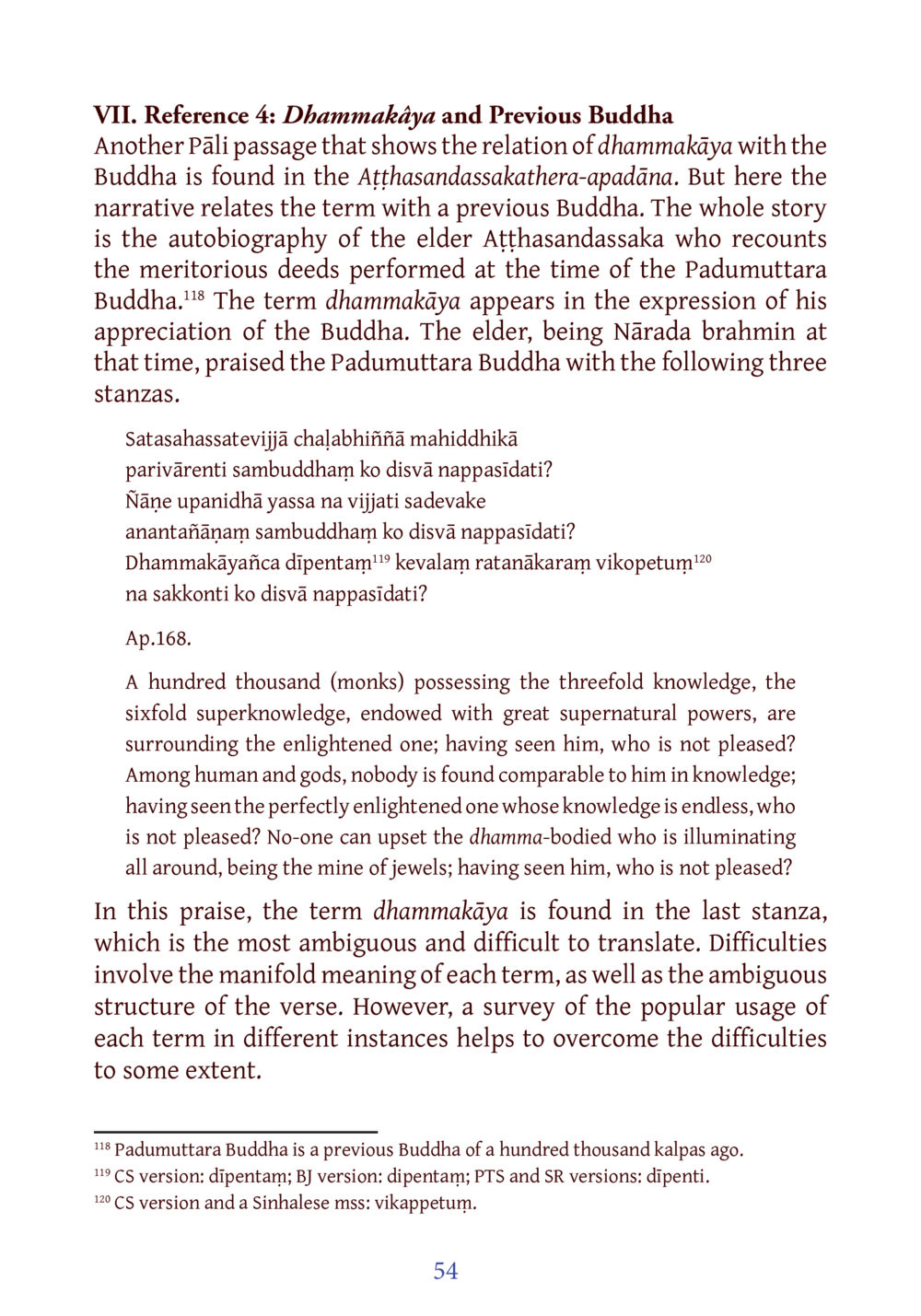Dhammakāya and the Previous Buddha : หน้า 75/141
DIRI Journal : หน้า 75/141 Exploration of the term Dhammakāya and its connection to Padumuttara Buddha as described in Atthasandassakathera-apadāna.
5 ครั้ง

สรุปเนื้อหา
บทความนี้วิเคราะห์ความสัมพันธ์ของคำว่า Dhammakāya กับพระพุทธเจ้าในพระอัฏฐสังคษา โดยมีการเล่าถึงชีวิตของพระอรหันต์ Atthasandassaka ที่มีความคิดถึงพระพุทธเจ้า Padumuttara และการยกย่องพระพุทธเจ้าในบทกวีสามบท โดยในบทสุดท้ายมีการกล่าวถึง Dhammakāya ที่มีความสำคัญต่อธรรมะและการเสริมสร้างความเข้าใจในความหมายที่หลากหลาย. จุดมุ่งหมายของเนื้อหาคือการทำความเข้าใจและตีความโดยอิงจากการใช้งานประจำวัน.
หัวข้อประเด็น
-ความสัมพันธ์ของ Dhammakāya กับพระพุทธเจ้า
-พระอรหันต์ Atthasandassaka
-การยกย่องพระพุทธเจ้า Padumuttara
-บทกวีในพระไตรปิฎก
-การตีความคำว่า Dhammakāya
ข้อความต้นฉบับในหน้า
VII. Reference 4: Dhammakāya and Previous Buddha
Another Pāli passage that shows the relation of dhammakāya with the Buddha is found in the Atthasandassakathera-apadāna. But here the narrative relates the term with a previous Buddha. The whole story is the autobiography of the elder Atthasandassaka who recounts the meritorious deeds performed at the time of the Padumuttara Buddha.118 The term dhammakāya appears in the expression of his appreciation of the Buddha. The elder, being Narada brahmin at that time, praised the Padumuttara Buddha with the following three stanzas.
Satasahassatevijja chaļabhiñña mahiddhika
parivārenti sambuddham ko disvā nappasidati?
Nāñe upanidhā yassa na vijjati sadeve
anantāññaṁ sambuddham ko disvā nappasidati?
Dhammakāyāñca dipentaṁ119 kevalaṁ ratanākaram vikopetuṁ120
na sakkonti ko disvā nappasidati?
Ap.168.
A hundred thousand (monks) possessing the threefold knowledge, the sixfold superknowlege, endowed with great supernatural powers, are surrounding the enlightened one; having seen him, who is not pleased? Among human and gods, nobody is found comparable to him in knowledge; having seen the perfectly enlightened one whose knowledge is endless, who is not pleased? No-one can upset the dhamma-bodied who is illuminating all around, being the mine of jewels; having seen him, who is not pleased?
In this praise, the term dhammakāya is found in the last stanza, which is the most ambiguous and difficult to translate. Difficulties involve the manifold meaning of each term, as well as the ambiguous structure of the verse. However, a survey of the popular usage of each term in different instances helps to overcome the difficulties to some extent.
118 Padumuttara Buddha is a previous Buddha of a hundred thousand kalpas ago.
119 CS version: dipentaṁ; BJ version: dipentaṁ; PTS and SR versions: dipenti.
120 CS version and a Sinhalese mss: vikappetuṁ.
หน้าหนังสือทั้งหมด

1

2

3

4

5

6

7

8

9

10

11

12

13

14

15

16

17

18

19

20

21

22

23

24

25

26

27

28

29

30

31

32

33

34

35

36

37

38

39

40

41

42

43

44

45

46

47

48

49

50

51

52

53

54

55

56

57

58

59

60

61

62

63

64

65

66

67

68

69

70

71

72

73

74

75

76

77

78

79

80

81

82

83

84

85

86

87

88

89

90

91

92

93

94

95

96

97

98

99

100

101

102

103

104

105

106

107

108

109

110

111

112

113

114

115

116

117

118

119

120

121

122

123

124

125

126

127

128

129

130

131

132

133

134

135

136

137

138

139

140

141
หนังสือที่เกี่ยวข้อง
Load More
